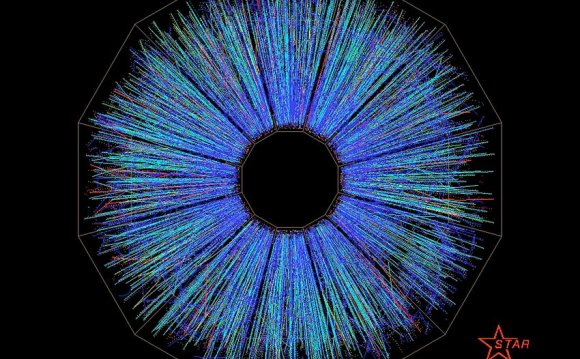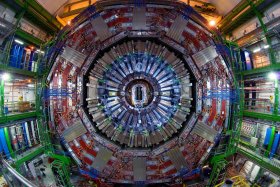
 CMS detector at CERN's Large Hadron Collider. Credit: CERN
CMS detector at CERN's Large Hadron Collider. Credit: CERN
Researchers at the University of Kansas working with an international team at the Large Hadron Collider have produced quark-gluon plasma—a state of matter thought to have existed right at the birth of the universe—with fewer particles than previously thought possible.
"Before the CMS experimental results, it had been thought the medium created in a proton on lead collisions would be too small to create a quark-gluon plasma, " said Quan Wang, a KU postdoctoral researcher working with the team at CERN, the European Organization for Nuclear Research. Wang performed key analysis for a paper about the experiment recently published in APS Physics.
"Indeed, these collisions were being studied as a reference for collisions of two lead nuclei to explore the non-quark-gluon-plasma aspects of the collisions, " Wang said. "The analysis presented in this paper indicates, contrary to expectations, a quark-gluon plasma can be created in very asymmetric proton on lead collisions."
The unexpected discovery was said by senior scientists associated with the CMS detector to shed new light on high-energy physics.
"This is the first paper that clearly shows multiple particles are correlated to each other in proton-lead collisions, similar to what is observed in lead-lead collisions where quark gluon plasma is produced, " said Yen-Jie Lee, assistant professor of physics at MIT and co-convener of the CMS heavy-ion physics group. "This is probably the first evidence that the smallest droplet of quark gluon plasma is produced in proton-lead collisions."
The KU researcher described quark-gluon plasma as a very hot and dense state of matter of unbound quarks and gluons—that is, not contained within individual nucleons.
 "It's believed to correspond to the state of the universe shortly after the Big Bang, " Wang said. "The interaction between partons—quarks and gluons—within the quark-gluon plasma is strong, which distinguishes the quark-gluon plasma from a gaseous state where one expects little interaction among the constituent particles."
"It's believed to correspond to the state of the universe shortly after the Big Bang, " Wang said. "The interaction between partons—quarks and gluons—within the quark-gluon plasma is strong, which distinguishes the quark-gluon plasma from a gaseous state where one expects little interaction among the constituent particles."
While high-energy particle physics often focuses on detection of subatomic particles, such as the recently discovered Higgs Boson, the new quark-gluon-plasma research instead examines behavior of a volume of such particles.
Quan Wang is at the Large Hadron Collider. Credit: University of KansasWang said such experiments might help scientists to better understand cosmic conditions in the instant following the Big Bang.
"While we believe the state of the universe about a microsecond after the Big Bang consisted of a quark-gluon plasma, there is still much that we don't fully understand about the properties of quark-gluon plasma, " he said. "One of the biggest surprises of the earlier measurements at the Relativistic Heavy Ion Collider at Brookhaven National Laboratory was the fluid-like behavior of the quark-gluon plasma. Being able to form a quark-gluon plasma in proton-lead collisions helps us to better define the conditions needed for its existence."
YOU MIGHT ALSO LIKE












